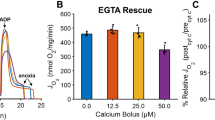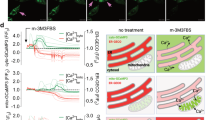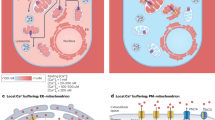Abstract
Increased mitochondrial Ca2+ accumulation is a trigger for the release of cytochrome c from the mitochondrial intermembrane space into the cytosol where it can activate caspases and lead to apoptosis. This study tested the hypothesis that Ca2+-induced release of cytochrome c in vitro can occur by membrane permeability transition (MPT)-dependent and independent mechanisms, depending on the tissue from which mitochondria are isolated. Mitochondria were isolated from rat liver and brain and suspended at 37°C in a K+-based medium containing oxidizable substrates, ATP, and Mg2+. Measurements of changes in mitochondrial volume (via light scattering and electron microscopy), membrane potential and the medium free [Ca2+] indicated that the addition of 0.3–3.2 μmol Ca2+ mg−1 protein induced the MPT in liver but not brain mitochondria. Under these conditions, a Ca2+ dose-dependent release of cytochrome c was observed with both types of mitochondria; however, the MPT inhibitor cyclosporin A was only capable of inhibiting this release from liver mitochondria. Therefore, the MPT is responsible for cytochrome c release from liver mitochondria, whereas an MPT-independent mechanism is responsible for release from brain mitochondria.
Similar content being viewed by others
Log in or create a free account to read this content
Gain free access to this article, as well as selected content from this journal and more on nature.com
or
Author information
Authors and Affiliations
Corresponding author
Additional information
Edited by D Green
Rights and permissions
About this article
Cite this article
Andreyev, A., Fiskum, G. Calcium induced release of mitochondrial cytochrome c by different mechanisms selective for brain versus liver. Cell Death Differ 6, 825–832 (1999). https://doi.org/10.1038/sj.cdd.4400565
Received:
Revised:
Accepted:
Published:
Issue date:
DOI: https://doi.org/10.1038/sj.cdd.4400565
Keywords
This article is cited by
-
MICU1 controls cristae junction and spatially anchors mitochondrial Ca2+ uniporter complex
Nature Communications (2019)
-
Cold atmospheric plasma causes a calcium influx in melanoma cells triggering CAP-induced senescence
Scientific Reports (2018)
-
Phosphocreatine protects against LPS-induced human umbilical vein endothelial cell apoptosis by regulating mitochondrial oxidative phosphorylation
Apoptosis (2016)
-
The endocannabinoid 2-arachidonoylglicerol decreases calcium induced cytochrome c release from liver mitochondria
Journal of Bioenergetics and Biomembranes (2012)
-
A mathematical model of mitochondrial swelling
BMC Research Notes (2010)



